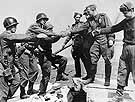
|
|
|

|

|

|

|
|
Click on an image to see a larger, more detailed picture.
|
|
|
|
|
| 1945: Liberation and Rebuilding |

|
pg. 580 |

|
|
|
|
| |
|
|
|
|
|
|
| |
On May 2 Roosevelt's successor, President Harry S. Truman, signed Executive Order 9547, appointing Justice Robert H. Jackson of the U.S. Supreme Court as chief U.S. counsel to the United Nations War Crimes Commission (UNWCC). The American, British, and Soviet governments had established the UNWCC on October 20, 1942, to ensure that Nazi war criminals would be brought to justice once the war ended. Truman's order also made Jackson the chief U.S. prosecutor at the planned international war-crimes trial, which opened officially at Nuremberg, Germany, on November 20. The war's devastation included an estimated 11 million people who remained uprooted from their home countries. Among them were former German prisoners of war, released slave laborers, and concentration-camp survivors (a large number of whom were Jewish). Confronting the immense task of helping these needy people, the Allies classified the refugees as "displaced persons" (DPs) and made the United Nations Relief and Rehabilitation Administration (UNRRA) responsible for them. At first, the UNRRA lacked sufficient personnel for this task, so much of the work involved in aiding the DPs fell to Allied military units. In the spring of 1945, about seven million DPs were in Occupied Germany. Gradually most went home, but more than a million were unwilling or unable to return to their native lands. They included about 50,000 Jews, as well as hundreds of Roma and Sinti (Gypsies) recently liberated from the concentration camps. Some non-Jews feared retaliation for their Nazi collaboration. Others feared persecution by Communist states. Jewish Holocaust survivors typically faced different dilemmas, as they could not return to their former homes because those homes no longer existed. The few Eastern European Jews who went home often experienced renewed antisemitism and found their property in the unfriendly hands of former neighbors. Liberation left the Jewish survivors less than free. Most were in poor health and plagued by horrific memories and nightmares. Jews found some relatives and friends alive, but more often they were struck with the news that loved ones had perished. Most Jews who wanted to escape postwar Europe completely in 1945 were not able to. Britain allowed merely a trickle of legal Jewish immigration to Palestine; illegal immigration was vigorously checked. Jewish refugees hoping to reach other countries, including the United States, usually found restrictions rather than open doors. In 1945 most Jewish Holocaust survivors had little choice but to stay in the hundreds of DP camps, which had been quickly established at such sites as former German Army barracks, prisoner-of-war camps, and even concentration camps such as Bergen-Belsen and Dachau.
|

|

|

|

|
|

On April 25, 1945, members of the U.S. First Army's 69th Infantry Division (left) and advance units of the Red Army's 58th Guards Division met at Torgau, Germany, on the Elbe River. The historic linkup cut Nazi Germany in two.
Photo: Wide World Photo
|
|
|
|
|
| 1945: Liberation and Rebuilding |

|
pg. 580 |

|
|
The Holocaust Chronicle
© 2009 Publications International, Ltd.
|
|
